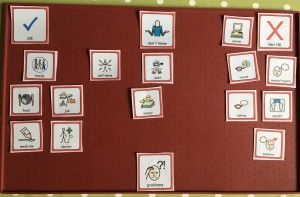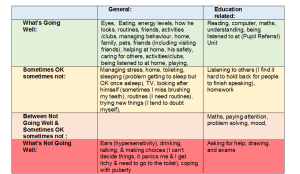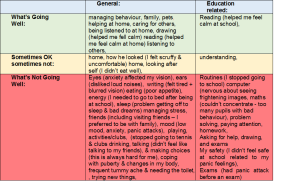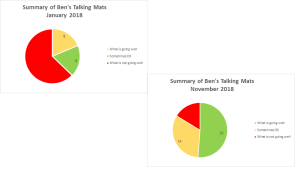Many thanks to Tina Wood, Occupational Therapist at Therapy In Motion, for this great example of how Talking Mats can be used to explore thoughts and feelings both in present-day and in retrospect, to evidence positive outcomes from a change in educational placement. Tina’s use of colour coding and pie charts really helps to illustrate this.
Tina attended our Talking Mats Foundation training back in September 2016 and since then she has been using Talking Mats regularly in her work as an Independent Occupational Therapist.
In this example, Tina has used Talking Mats to enable Ben (name changed for anonymity, age 12½ years) to share his thoughts and feelings using the Talking Mats ‘Consulting Children and Young People’ resource packs – focusing on the topics ‘My Body and Skills’ and ‘What I do and Support’.
At the time of this Talking Mat, Ben had been accessing a new placement at a Pupil Referral Unit for the past 11 months (click on the picture below to see a clearer version).
As there was clearly a difference in how Ben felt things were going when he was attending his previous school, Tina decided to ask him to do a retrospective Talking Mat of how things were going for him 11 months ago in January 2018, when he started to feel “unwell”.
This enabled comparison with how he feels now in the “safe setting” of the Pupil Referral unit (click on picture to see a clearer version).
Tina then compiled the information from the above tables into pie charts, enabling a clear visual comparison between the two times/situations (click on picture to see a clearer version):
As can be seen from these charts, there had been a huge change in Ben’s perception of how he is coping with life in general and school in particular.
Tina recommended that this information needs to be considered along with the rest of Ben’s sensory needs (as reported in her full OT report) when deciding on what is the best educational setting for him after leaving the pupil referral unit.
We love this use of colour coding and pie charts to illustrate the information from Ben’s Talking Mats – to really ensure that Ben’s feelings and thoughts are seen and heard.
If you would like to know more about accessing Talking Mats training – available across the UK and Ireland as well as online – please take a look here: https://www.talkingmats.com/training/
If you have any examples of how you report/share information about completed Talking Mats we would be interested to hear about it! Just email laura@talkingmats.com
Thanks so much to all the practitioners who have sent us guest blogs about using Talking Mat in a Criminal Justice setting. Here are our top 5 – in no particular order!
1. Supporting Families in the Criminal Justice System: Sally Kedge, Speech and Language Therapist from Trouble Talking New Zealand shares two powerful case examples of using Talking Mats with children and families caught up in the criminal justice system. https://www.talkingmats.com/support-for-prisoners-families-experience-from-new-zealand/
2. Communication Needs within Youth Justice – Part 1: On 17th April 2017, we organised a seminar to look at underlying issues and share good practice when addressing the communication needs of people in youth justice. We had representatives from: the Scottish government, the NHS; Third sector organisations working in youth justice, the police, social workers, professional bodies, universities and social work – from as far afield as New Zealand. The emphasis from the start was that understanding communication is key to improving service delivery. https://www.talkingmats.com/communication-needs-in-youth-justice/
3. Communication Needs within Youth Justice – Part 2: The afternoon session of our seminar on 17.04.17 continued the underlying theme that communication support needs are often hidden and many looked after children have support needs that remain unidentified. The outcome of the day was the establishment of a collaborative network. https://www.talkingmats.com/youth-justice-and-communication-needs-2/
4. Setting up a SLT Service in Prison: This inspiring blog by Jacqui Learoyd explores her role in setting up a speech and language therapy ( SLT ) service in a prison and her use of Talking Mats in that setting https://www.talkingmats.com/setting-up-an-slt-service-in-prison/
5. Has Talking Mats been used in Court? Two registered intermediaries talk about a couple of cases where Talking Mats was used as part of the achieving best evidence (ABE) interviews. https://www.talkingmats.com/talking-mats-used-court/
If you have been inspired and are not yet trained, come along to one of our Foundation training courses – for details see https://www.talkingmats.com/training/foundation-training/
We also offer online training if you are unable to access the training locations – for details see https://www.talkingmats.com/training/online-training/
This blog by Jacqui Learoyd explores her role in setting up a speech and language therapy ( SLT ) service in a prison and her use of Talking Mats in that setting . HMP Berwyn is a large prison which opened in February 2017. To help you understand the challenges facing me when setting up this service in a new prison, I’ll tell you something about prisons, the people in prison, and the healthcare provision at HMP Berwyn.
In the UK the prison population is just growing and growing. The graphic above is taken from the Commons Library Briefing of April 2017 so that you can see the trend. The number of people in the prison system as of April 2018 is 83,617. The reoffending rate is about 30%.
From this data alone, we can see that something needs to change in order to reduce offending and re-offending. Part of the ‘something which needs to change’ is considering offender rehabilitation / prison reform. This led to the building of the UK’s newest prison – HMP Berwyn.
We tend to shorten the name of the prison to just ‘Berwyn’, so that is what I will call it in this short piece. Berwyn has a focus on rehabilitation and treating people as individuals. We aim for the provision of high quality healthcare. We have space for 2106 gentleman – which makes us quite a large facility. We also give attention to the words which we use in our daily conversations – the clients are not called prisoners, but ‘men’, the cells are ‘rooms’, people are called by their first names, etc.
The healthcare provision is an integrated multidisciplinary team with a mix of professionals offering a range of skills. It’s called the Health and Wellbeing Team as it offers holistic care to our clients. I’m happy to say that this includes full time Speech and Language Therapy (SLT), which is where I come in.
Speech and Language Therapy is necessary in a prison setting as a significant proportion of people in the criminal justice system will have speech, language and communication needs. Some research suggests that this may be as high as 91% (Brooks, 2011). Many of these people will not have accessed SLT in the past, and will have developed their own strategies in hiding their difficulties. This is why communication impairment is a hidden disability in this client group. Alongside this, people in prison experience much worse mental and physical health compared with the general population. There are more head injuries, more illnesses caused by drugs and alcohol, higher numbers of people with diagnosed mental illness and more people with conditions such as ADHD. The prison population is aging, so we have all the illness which link with an aging population too, such as strokes, dementia, cancers. You can see that as a service, we are going to be kept very busy!
We’ve got lots of plans for how to tackle some of the things which we want to do as an SLT service, but something which we have already achieved is using Talking Mats.
My first thought was how the men at Berwyn would respond to a conversation using a set of symbols and a doormat. Needless to say, they took it to without question – even the toughest looking customers who had been ‘inside’ for many years happily sat down with me to chat using the tool. Not only did they tolerate the Talking Mat, but they loved it – reporting that they were able to organise their thoughts and report their views more easily.

Some clients wanted to say more about emotions following completing the ‘problems’ Talking Mat. We used a ‘me’/’not me’ visual scale and symbols to represent emotions. This Talking Mat requires the client to have some emotional awareness skills so that they can recognise what they are feeling. Not all of the clients are at this stage, and it is especially hard for depressed people to access their emotions vocabulary (Bryan,2013).
Here is an example of this Talking Mat. This information could be used as a starting point to develop an emotions safety plan with an individual. After completing this Talking Mat with a 21 year old man who has a significant history of Adverse Childhood Events, he wanted to make his own Talking Mat about his life experiences. This is a young man who finds expressing his emotions and past very difficult. I was quietly excited that he was prepared to share more information. We have sat together and used the symbol software to make his symbols, and next week I will get to see what he is going to tell me.
And lastly, we have met some clients who have a diagnosis of an Autistic Spectrum Condition. They had attracted this diagnosis during their teen or adult years, but had limited understanding of what Autism is or how it affects them on a personal basis. Being in prison, they can’t Google to find out more as you and I might.
We have developed a Talking Mat which explores ‘what is Autism?’ and allows the client to learn while they report on what having autism feels like for them. We hope to develop the responses on this Talking Mat into a person centred communication passport which can be shared to help all their communication partners.
We keep thinking about ‘what next?’ with the clients and the SLT service, and we continue to develop symbol sets for more Talking Mats conversations. Often we are being led by the clients in terms of what they need in Talking Mat form.
We have strong links in the wider team, so will be doing more Talking Mats work with psychology, substance misuse and nursing colleagues. We hope to access the Talking Mats Accredited Training and expand the number of people using Talking Mats to include Offender Managers and Prison Officers. Alongside this we are developing healthcare pathways for clinical work such as end of life care, so will be applying the Talking Mats methodology to advanced care planning. There’s a lot to do!
Postscript
If any of you want you to link with Jacqui to discuss this further please let us know and we will link you with her. If you want to become confident and skilled at using Talking Mats then please come on a training We also have an online course
References
Brooks, V., 2011. Report outlining the findings of a 13 month pilot project examining the effectiveness of speech and language therapy for young people known to Exeter, East and Mid Devon Youth Offending Team. East and Mid Devon Youth Offending Team.
Bryan, K. (2013). Psychiatric disorders and communication. In L. Cummings (Ed.), The Cambridge Handbook of Communication Disorders (Cambridge Handbooks in Language and Linguistics). Cambridge: Cambridge University Press. doi:10.1017/CBO9781139108683.020
Addressing the communication needs of people in youth justice is key to improving lives. The lack of attention to this is costly. On the 17th of April, we organised a seminar to look at the underlying issues and share good practice.
We were delighted with the collaborative mix of people attending. We had representatives from: the Scottish government, the NHS; Third sector organisations working in youth justice, the police, social workers, professional bodies, universities and social work.
Our thanks to Professor Richard Simpson for chairing the day and setting the tone by emphasising from the start that understanding communication is key to improving service delivery. Following his introduction a series of excellent and stimulating presentations took place creating a fusion of ideas and practice from Scotland and New Zealand.
- Kim Hartley Kean, head of the Royal College of Speech and language therapy Scotland office highlighted the current position in Scotland
- Sally Kedge and Alayne Mckee described the approach adopted by their organisation Talking Trouble in New Zealand.
- Jane Macer the therapeutic service co-ordinator from Starley Hall Fife described an whole system approach to embedding good communication practice within an organisation
- Yvonne McKeown and Sandra Polding Speech and Language Therapists working with young people in a NHS inpatient psychiatric unit in Glasgow shared some case examples.
In different ways the speakers brought up very similar themes:
- Communication can be treated glibly. There is a lack of understanding of what communication difficulties are and of the impact that they have on the lives of young people. These difficulties are often hidden and take time to identify. Lack of identification can have a huge impact on the future lives of young people.
- Finding ways to hear the young person’s voice is key both for the young person but also for organisations in order to deliver appropriate and effective care.
- Recognition of the intergenerational cycle and the importance of getting care and support correct so we break patterns and enable change.
- Providing collaborative solutions and understanding the breadth of communication will help services improve. However, given services often don’t know what they don’t know in terms of the impact of communication difficulties we have to find ways to express those solutions in language that those services can relate to and understand. Listening to organisations and exploring their processes by analysing the communicative demands of each stage can be a helpful way to start.
- Moving forward it is important to knock on open doors i.e. work with people who are receptive to recognising the impact of communication difficulties on young people and their lives but also find the strategic influencers who are sympathetic, in the words of our New Zealand colleagues ‘the aunts and uncles in the field’ who can help to promote the issue and raise awareness at a National level.
- You can’t explore the issue of trauma and adverse childhood experiences without certain precursor, building blocks being in place. This takes time and requires a constancy of approach.
- The importance of inclusive, visual tools becoming common place so that they are not used in isolation and in a vacuum.
- The challenge of supporting and nurturing a young person’s inner voice when they have significant difficulties with language.
- Lack of understanding of communication difficulties may lead to services responding to internalized behaviours that can lead to a fork in life; one way can send the young person down a route of offending behaviour services and the other mental health services.
- The solutions lie in partnership and collaboration between professions and services.
There were lots of creative ways of using Talking Mats that were shared. A couple of examples that stand out were
- Using Talking Mats with social workers to help them unpick what they already know about a young person’s language and communication. This approach helped them think about all the different aspects that contribute to communication and where the young person’s strengths and weaknesses lay e.g. non verbal communication , humour , word finding , understanding complex information, understanding simple information etc .
- Using Talking Mats to support a psychiatric assessment of a young person. One person used his Talking Mat to say he was hearing voices something he was unable to disclose verbally. In this case this enabled an accurate mental state assessment and non-custodial sentence.
I will leave the last word to a young man living in an inpatient unit to support his mental health, his words about communication difficulties are ‘They make you more vulnerable when bad stuff happens’ how true that is and this is why it is important we work together to improve services .
Next steps The community justice network met in the afternoon and were challenged to think about the opportunities and barriers in developing services – read the for blog that covers the afternoon ……… If you missed the seminar and want to join a multiagency network to discuss this and help take this forward in Scotland then please let us know .
Click to read the excellent presentations from the seminar
 Online training login
Online training login 








